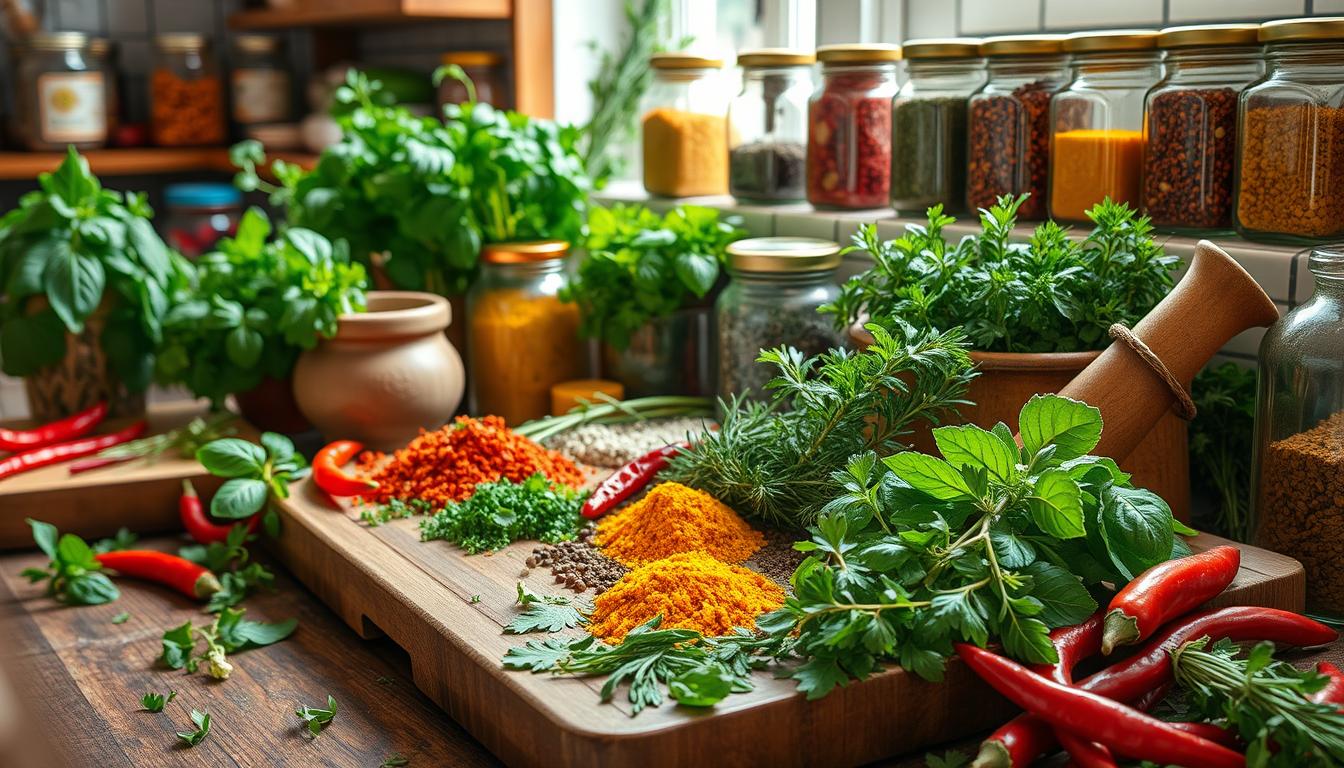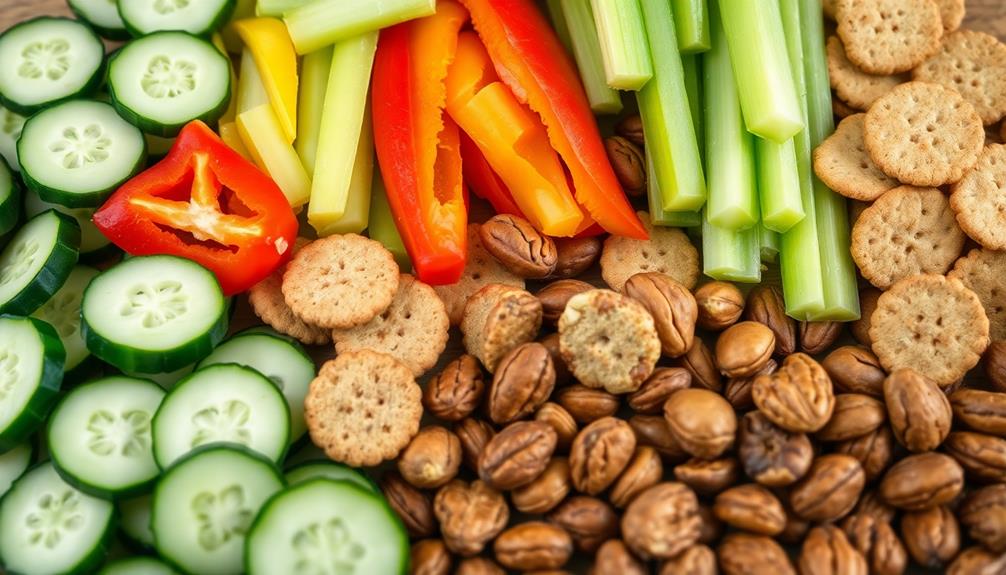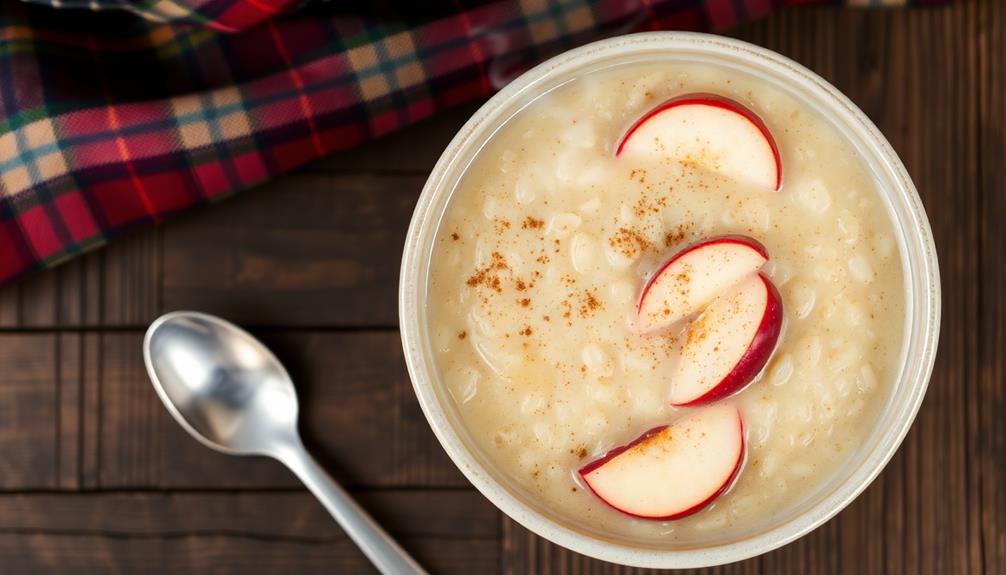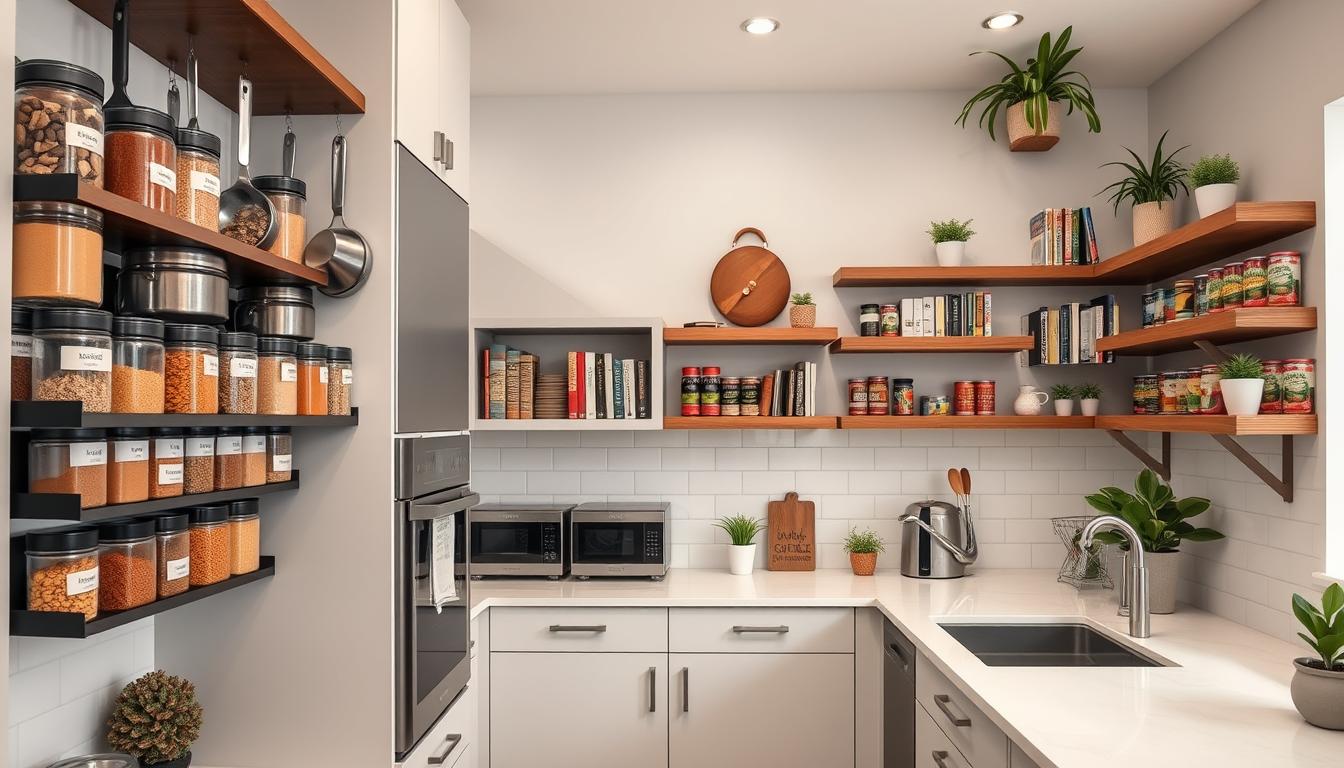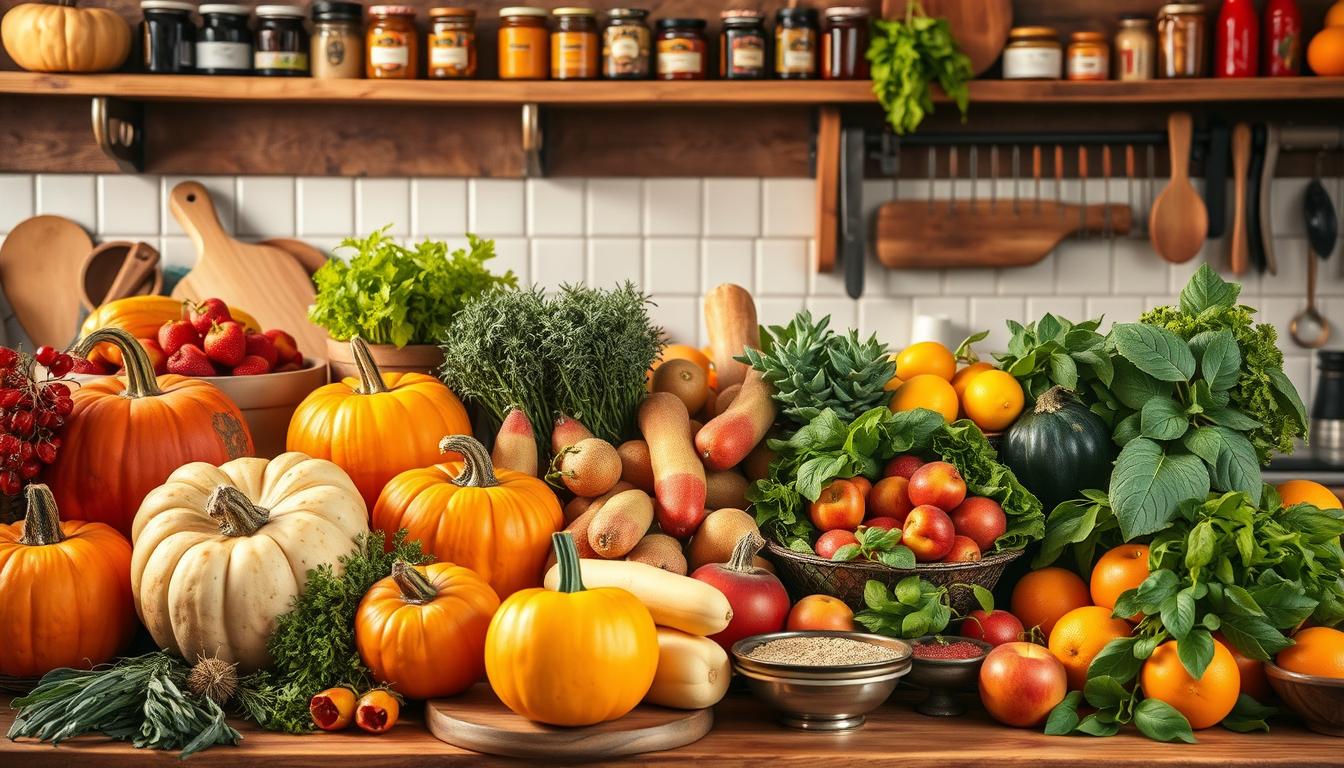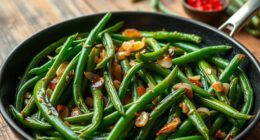Imagine walking into your kitchen, the air infused with the intoxicating aromas of fresh herbs and spices, each scent telling a story, igniting memories of home-cooked meals shared with loved ones. Cooking with herbs and spices is not merely about flavor—it’s an invitation to awaken your senses and transform everyday meals into extraordinary experiences. You don’t have to be a gourmet chef to elevate flavors; with just a sprinkle or a dash, you can turn simple ingredients into flavorful masterpieces that nourish both body and soul.
In this journey, we’ll explore the vibrant world of herbs and spices, revealing how they can enhance your cooking, making meals healthier without excess fat, salt, or sugar. You’ll discover practical tips for choosing between fresh and dried varieties, ingenious cooking techniques, and the profound benefits that come from incorporating these powerhouse ingredients into your culinary repertoire. Your kitchen can be a sanctuary of creativity and health, filled with the potent flavors that herbs and spices bring to the table.
Key Takeaways
- Fresh herbs enhance dishes with vibrant flavors and can be found in grocery store produce sections.
- Dried herbs are shelf-stable, typically located in the spice aisle, and require careful measurement in recipes.
- Cooking techniques vary for delicate versus sturdier herbs; timing is crucial for optimal flavor.
- Statistics show that adding herbs to meals can increase vegetable consumption, especially among teenagers.
- Many herbs and spices also provide potential health benefits, such as antioxidant and anti-inflammatory properties.
Understanding Herbs and Spices
In your culinary journey, understanding herbs and spices is crucial for elevating flavors. At first glance, you might think herbs and spices serve similar purposes, but the difference between herbs and spices is significant. Herbs typically come from the leaves of plants, while spices are derived from other parts such as seeds, roots, bark, or berries.
Let’s explore some common culinary herbs and spices that can transform your meals:
| Culinary Herbs | Health Benefits | Common Uses |
|---|---|---|
| Basil | Anti-inflammatory, antibacterial | Italian dishes, pesto |
| Cilantro | High in fiber, iron | Indian, Mexican cuisines |
| Dill | Rich in iron, calcium | Paired with salmon, eggs |
| Mint | Freshens breath, aids digestion | Salads, desserts, teas |
| Bay Leaves | Rich in vitamins | Adds flavor to soups and stews |
Spices can bring depth and complexity to your dishes. Here are a few essential spices:
| Spices | Flavor Profile | Health Benefits |
|---|---|---|
| Cinnamon | Sweet, spicy | Regulates blood sugar |
| Ginger | Warm, zesty | Anti-inflammatory properties |
| Cumin | Earthy, pungent | Aids digestion, rich in antioxidants |
| Cardamom | Sweet, spicy | Rich in antioxidants |
| Paprika | Sweet, smoky | Boosts metabolism |
Fresh herbs add vibrant flavor and can be used as garnishes. In contrast, spices are often used in their dried form, providing concentrated flavors. When you grasp the difference between herbs and spices, you can harmoniously blend them to create a magnificent culinary experience.
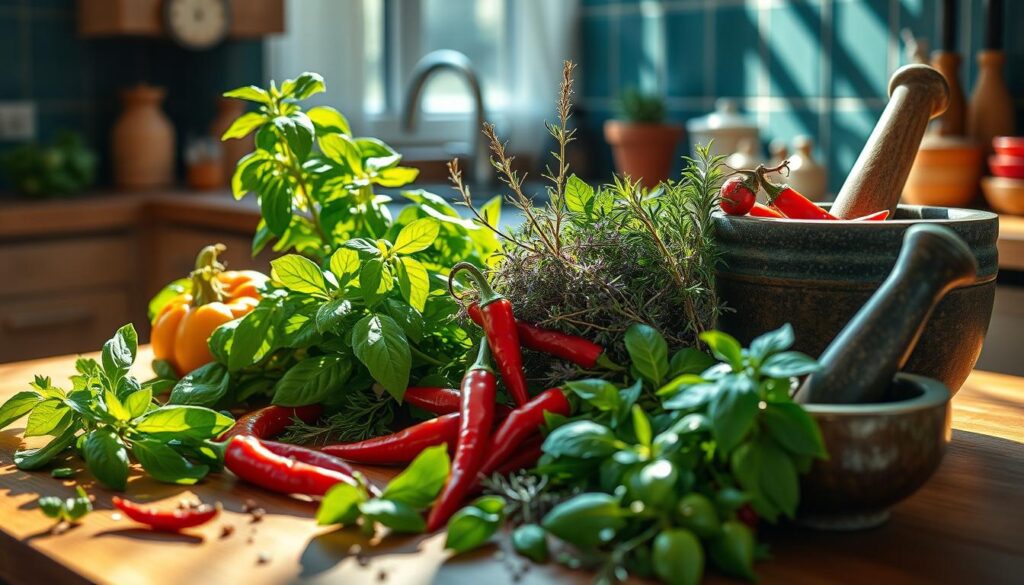
Buying Fresh vs. Dried Herbs
When it comes to buying fresh herbs versus dried herbs, understanding the advantages and disadvantages of each can greatly enhance your cooking experience. Fresh herbs offer vibrant flavors, particularly in dishes that highlight them—like salads or as garnishes. However, their short shelf life means that you’ll need to be strategic about usage to avoid waste. Many home cooks find fresh herbs relatively expensive, often leading to unused portions that spoil quickly.
On the other hand, dried herbs are more convenient and have a longer shelf life, making them ideal for a variety of cooking applications, such as sauces, stews, and soups. These herbs maintain good flavor over time and can easily be mixed into cooked dishes for a depth of taste. Certain herbs like oregano, thyme, and rosemary provide concentrated flavors, which are perfect for longer cooking times. Unlike delicate leafy herbs that lose their flavor when dried, dried herbs hold their potency.
A useful conversion guideline is to remember the ratio: use only 1/3 of the amount of dried herbs compared to fresh in recipes. For example, if your recipe calls for 1 tablespoon of fresh basil, use 1 teaspoon of dried basil. If you are using ground dried herbs, consider that 1 tablespoon of fresh equates to about 3/4 teaspoon of the ground version. This simple conversion helps maximize herb quality while ensuring your dishes remain flavorful.
| Herb Type | Fresh Amount | Dried Amount | Ground Amount |
|---|---|---|---|
| Cilantro | 1 tbsp | 1 tsp | 3/4 tsp |
| Dill | 1 tbsp | 1 tsp | 3/4 tsp |
| Oregano | 1 tbsp | 1 tsp | 3/4 tsp |
| Rosemary | 1 tbsp | 1 tsp | 3/4 tsp |
| Thyme | 1 tbsp | 1 tsp | 3/4 tsp |

Whichever option you choose, the way you store these herbs plays an essential role in preserving their quality. Fresh herbs can be kept in a glass container with water, similar to a bouquet. Changing the water every couple of days helps maintain freshness. Dried herbs should be stored in an airtight container in a cool, dark place to prolong their flavor and effectiveness. Selecting high-quality herbs, whether fresh or dried, ensures you get the best flavor potential for your dishes.
Cooking Techniques Using Herbs
Utilizing the right cooking techniques using herbs enhances the natural flavors in your dishes. Precise timing and proper herb application can significantly elevate your culinary skills. When working with fresh herbs, adding them at the end of the cooking process retains their vibrant flavors. This technique works well for herbs like basil and dill, commonly used in dishes with fish or pasta.
Dried herbs are best incorporated early in the cooking process, allowing heat to extract their unique essences. For instance, consider using oregano and cumin in your stews and chili dishes. These herbs infuse their flavor into the entire dish, providing depth and warmth. A skilled cook understands when to apply each type of herb for maximum impact, making these culinary techniques invaluable.
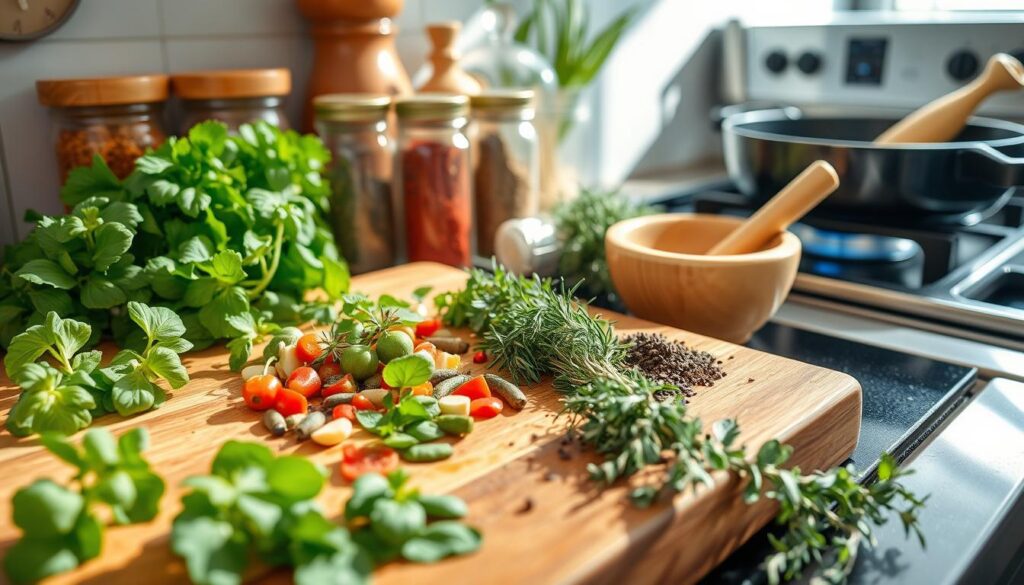
To help you master these techniques, here’s a detailed comparison table that shows various herbs, their optimal cooking time, and recommended dishes:
| Herb | Optimal Cooking Time | Recommended Dishes |
|---|---|---|
| Basil | Fresh: add at the end; Dried: early | Pasta, Pesto, Meats |
| Cumin | Early | Chili, Stews, Vegetables |
| Cinnamon | Early | Chilis, Stews, Baked Goods |
| Cardamom | Early | Chai, Garam Masala |
| Cayenne Pepper | Early (increases heat) | Chili Powders, Soups |
| Garlic | Early | Soups, Sauces, Meats |
| Ginger | Early | Teas, Stir-fries |
| Dill | Fresh: add at the end | Salmon, Dips |
Understanding these distinctions in herb application will not only enhance your dishes but also enable you to create robust flavor profiles while mastering essential culinary techniques. Create unforgettable meals as you explore the world of herbs, combining their unique characteristics to suit your palate. Enjoy your cooking journey!
Benefits of Using Herbs in Cooking
Incorporating herbs into your meals offers numerous health benefits and enhances the nutrition from herbs in a delightful way. These flavorful additions do more than improve taste; they provide rich sources of antioxidants and other essential nutrients that positively impact health. Many herbs come from the leaves and stems of plants, while spices derive from seeds, roots, flowers, or bark. Surprisingly, some plants, like cilantro and dill, can function as both herbs and spices, showcasing their versatility.
The Mediterranean diet promotes a hearty intake of fruits and vegetables, yet it often overlooks the value of herbs, which can deliver a spectrum of nutrients. For instance, turmeric, rosemary, and garlic support the immune system thanks to their potent antioxidant properties. In addition, hot red peppers contain capsaicin, which acts as an antioxidant that might boost metabolism and reduce stomach acid.
Many herbs contribute to heart health by lowering LDL cholesterol, reducing inflammation, and preventing plaque buildup. Chili peppers, turmeric, garlic, and parsley are prime examples of these beneficial ingredients. Furthermore, herbs like parsley, sage, and thyme can improve bone health with vital nutrients such as potassium and vitamin K. Oregano, rich in antioxidants, showcases potential antibacterial and antifungal properties, further demonstrating the nutritional value herbs carry.
Other notable herbs, including sage and cinnamon, highlight impressive health benefits. Sage is packed with vitamins K, A, E, and C, exhibiting antimicrobial effects that promote oral health. Cinnamon, native to Sri Lanka and Myanmar, boasts powerful anti-inflammatory properties known to enhance insulin resistance. Additionally, ginger, recognized for its anti-nausea qualities, helps lower blood sugar levels, protect brain function, and may even prevent Alzheimer’s disease.
It’s clear that the benefits of using herbs in cooking extend beyond flair and spice. These magical ingredients elevate the flavors in your dishes while simultaneously working wonders for your health.

Cooking with Herbs and Spices
Cooking with herbs and spices opens up a world of flavors and health benefits. Understanding how to create unique flavor profiles transforms your culinary experience. The right combination can elevate a dish, bringing out its best qualities while adding nutritional value.
Creating Flavor Profiles
Creating flavor profiles involves blending various herbs and spices that complement each other. For instance:
- Allspice enhances North American desserts like pumpkin pie.
- Anise adds a sweet, aromatic note to Italian sausage and anise cookies.
- Basil is integral to pizza and pasta, defining Italian cuisine.
- Bay leaves provide an earthy depth to soups and stews.
- Cinnamon pairs beautifully with baked apple dishes, enhancing flavors.
- Cumin adds warmth to chutneys and chili dishes.
- Curry powder combines turmeric, fenugreek, and cumin, creating a dynamic spice blend.
- Ginger introduces heat to Asian and Caribbean recipes.
When experimenting with flavor combinations, start with small test batches. Adding 1/8 teaspoon of each herb or spice to a small portion of food allows you to taste and tweak before incorporating it into the larger dish.
Using Herbs for Health Benefits
Incorporating herbs for health benefits not only boosts flavor but also contributes to overall wellness. Consider these examples:
- Garlic is renowned for its immune-boosting properties.
- Cilantro may offer detoxifying benefits while enhancing Latin and Indian dishes.
- Mint has cooling properties that aid digestion in spicy fare.
Seasonings can also impact health. Reducing salt intake by using herbs like black pepper or garlic powder preserves flavor without the sodium. Similarly, using sweet spices such as ginger or mint helps reduce sugar content while maintaining a perception of sweetness.
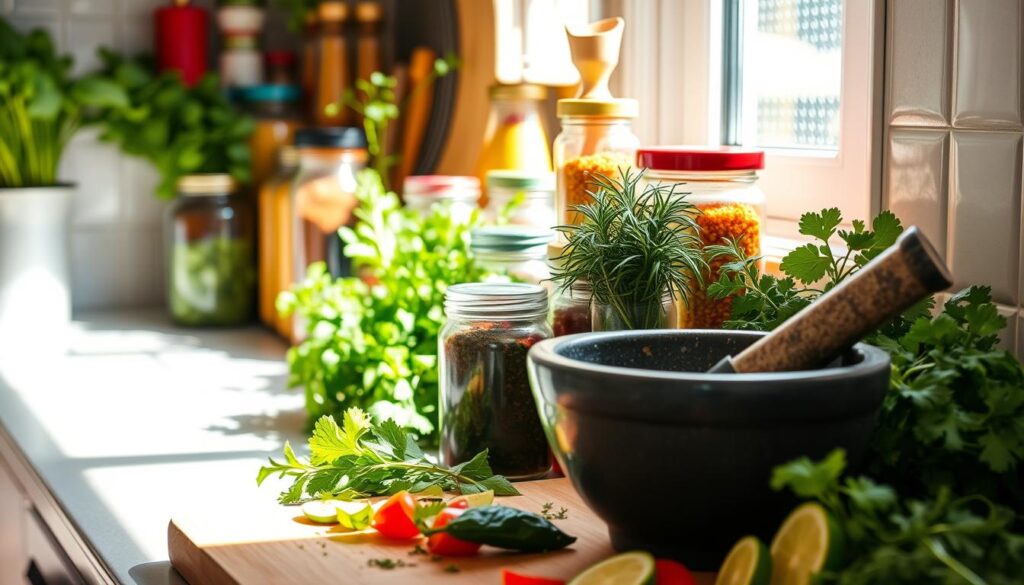
Explore the vibrant world of herbs and spices to create dishes that not only taste delightful but also nourish your body.
| Herb/Spice | Flavor Profile | Health Benefits |
|---|---|---|
| Allspice | Warm, sweet | Antioxidant properties |
| Anise | Sweet, licorice-like | Digestive aid |
| Cilantro | Citrusy, fresh | Detoxification |
| Cinnamon | Warm, sweet | Blood sugar regulation |
| Garlic | Pungent, savory | Immune support |
| Ginger | Spicy, zesty | Anti-inflammatory |
Herb and Spice Recipes to Try
Exploring herb and spice recipes opens up a world of flavor and culinary creativity. You can enhance your meals using various herbs and spices, providing a delightful twist to everyday dishes. This section presents flavorful suggestions, focusing on meats optimal combinations and vegetable seasoning tips for maximum taste and health benefits.
Meats: Optimal Combinations
When it comes to meats, pairing the right herbs and spices can transform the simplest cuts into amazing gourmet meals. Here are some suggestions:
- Cinnamon and cumin work beautifully with pork, adding warmth and depth.
- Thyme and rosemary can elevate the flavors of beef, delivering a savory punch.
- Cilantro and garlic powder make great companions for chicken, infusing freshness and a burst of flavor.
- Chili powder and paprika bring boldness to grilled fish, perfect for sunny days.
These meats optimal combinations not only taste amazing but also incorporate health benefits, such as antioxidants from spices like ginger and anti-inflammatory properties from turmeric.
Vegetable Pairings and Seasoning Tips
Vegetables can shine with the right seasoning. Here are some effective vegetable seasoning tips to enhance taste:
- Mint is delightful paired with peas and carrots, offering a refreshing contrast.
- Oregano and parsley complement roasted vegetables, adding aromatic notes.
- Bay leaves work well in hearty vegetable soups, rounding out the flavors.
- Smoked paprika and cayenne pepper can add a kick to sautéed greens.
Experimenting with these herb and spice recipes enriches your cooking, allowing you to enjoy the numerous health benefits that come from fresh and dried herbs, including protection against chronic diseases such as heart disease and arthritis.

Spice Combination Tips for Flavor Enhancement
Creating delightful dishes often hinges on your ability to combine spices effectively. Understanding the nuances of each spice can lead to incredible flavor enhancement in your meals. Here are some essential spice combination tips to elevate your culinary creations. When experimenting with spice combinations, it’s important to start with a solid foundation of common pairings, such as cumin and coriander, or cinnamon and nutmeg. From there, don’t be afraid to explore top flavors that complement each other, such as using paprika and garlic to add depth to your dishes. By taking the time to understand how different spices interact with one another, you can create a truly memorable dining experience for yourself and others.
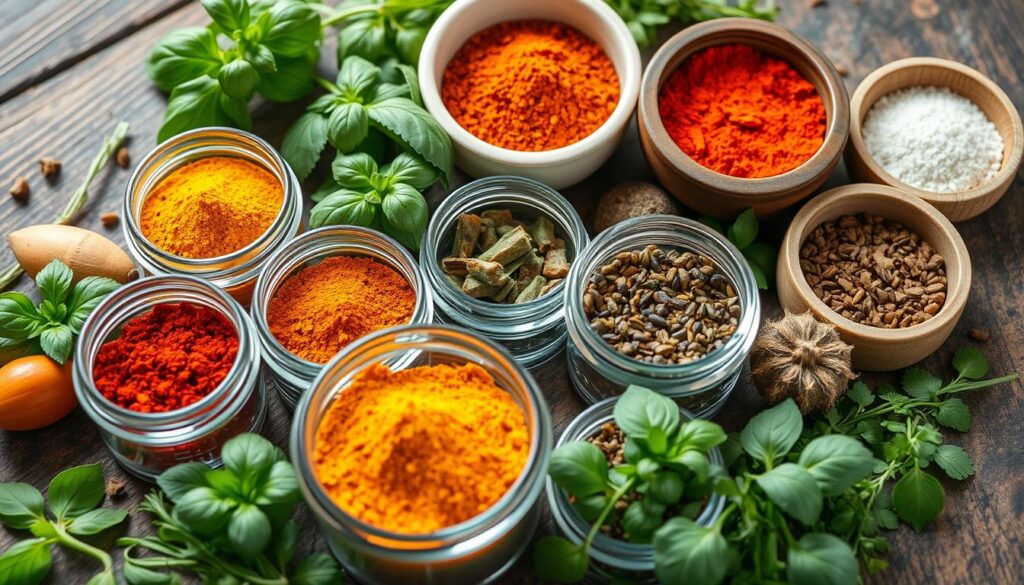
Start by recognizing the potency of spices such as chili pepper, cumin, and black pepper. For instance, chili pepper, originating from Central and South America, contains capsaicin, which produces heat. Use it sparingly when experimenting with different herb blends to avoid overwhelming other flavors. On the other hand, cumin—widely used in numerous cuisines—pairs beautifully with coriander seeds, known for their delicate lemon zest flavor.
When creating your herb blends, consider balancing earthy and bright flavors. For example, combining true cinnamon from Sri Lanka with cardamom creates a warm, aromatic base perfect for autumn recipes. Use cayenne pepper for an added kick, recognizing that its flavor intensifies during cooking.
- Chili Powder: A mixture of ancho chili, paprika, cumin, and oregano works well in soups and marinades, enhancing a variety of dishes.
- Curry Powder: A blend including turmeric and chili provides depth to stews and meats, making it a staple in cooking.
- Garlic & Ginger: These potent spices not only add flavor but also bring numerous health benefits, enriching your meals.
Experimentation is vital in discovering unique pairings that work for your palate. Start small, taking notice of how differing spices interact. Soon enough, you’ll find your rhythm in crafting herb blends that transform ordinary meals into extraordinary culinary experiences.
| Spice | Origin | Flavor Profile |
|---|---|---|
| Chili Pepper | Central and South America | Spicy, hot |
| Coriander Seeds | Parsley family | Delicate lemon zest |
| Cumin | Northern Africa, Middle East | Earthy, warm |
| True Cinnamon | Sri Lanka | Sweet, complex |
| Cardamom | India | Aromatic, spicy |
Seasoning with Herbs and Spices: A Guide
Effective seasoning with herbs and spices transforms ordinary meals into culinary delights. Understanding how to use these ingredients properly will enhance your cooking skills significantly. This seasoning guide offers you essential tips and practical insights to season your dishes like a pro.
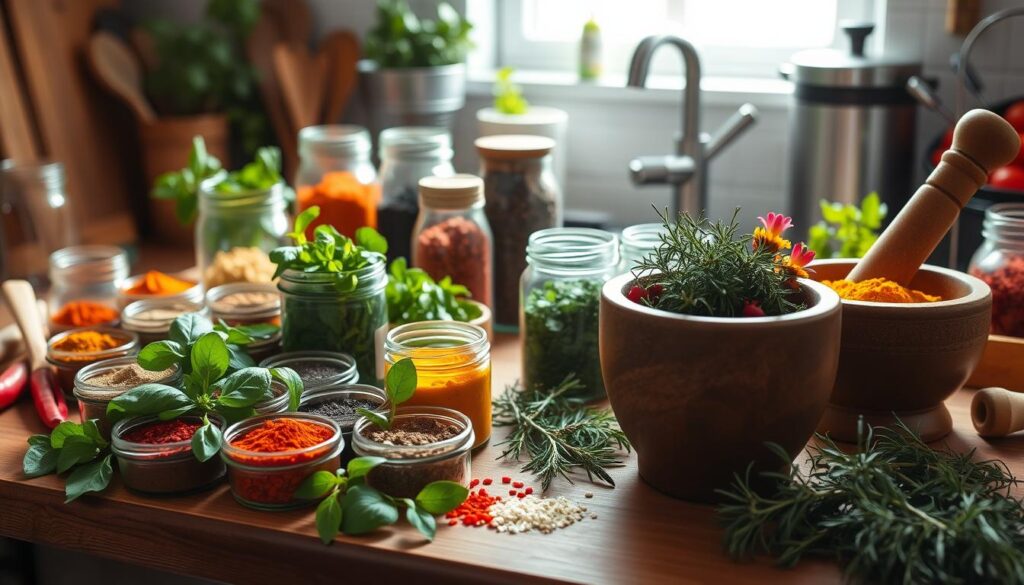
Start by knowing the equivalent amounts when using fresh versus dried herbs. Typically, 1 tablespoon of finely cut fresh herbs equals 1 teaspoon of crumbled dried herbs or ¼ to ½ teaspoon of ground dried herbs. Adjusting the quantity is crucial for achieving the desired flavor without overwhelming your dish.
Incorporating a variety of herbs can add health benefits along with flavor. For instance, garlic can lower blood pressure, while ginger offers anti-cancer properties. Using spices like cinnamon may even help in managing blood sugar levels. Understanding these culinary tips will allow you to cook not only delicious food but also nutritious meals.
Consider the freshness of your herbs and spices. Whole spices can maintain their potency for up to 2 years, whereas ground spices usually have a shelf life of around 6 months. Proper storage is essential; red spices, like paprika and red pepper, benefit from refrigeration.
Tasting your creation as you cook is vital. Adjust seasoning incrementally and remember that flavors often develop further as they meld. This technique ensures your meal meets your personal standards for seasoning.
| Herb/Spice | Health Benefits | Storage Tips | Fresh vs. Dried |
|---|---|---|---|
| Bay Leaf | Rich in vitamins and minerals | Store whole leaves in a cool, dry place | 1 tbsp fresh = 1 tsp dried |
| Cayenne Pepper | May relieve pain and lower cholesterol | Refrigerate for freshness | 1 tbsp fresh = 1 tsp dried |
| Cinnamon | May lower blood sugar and reduce inflammation | Store in an airtight container | 1 tbsp fresh = 1 tsp dried |
| Ginger | Reduces menstrual pain and fights infections | Refrigerate in a paper towel | 1 tbsp fresh = 1 tsp dried |
| Garlic | Lowers blood pressure and improves cholesterol | Store in a cool, dry place | 1 tbsp fresh = 1 tsp dried |
With this seasoning guide, you now have the foundation for elevating your dishes. Mastering the art of seasoning with herbs and spices will not only improve flavor but also infuse your cooking with health benefits, making every meal a purposeful experience.
Conclusion
As you wrap up your exploration of cooking with herbs and spices, remember that these vibrant ingredients are essential for elevating the flavors and nutrition of your meals. Whether you’re adding basil to a classic Italian pasta dish or using turmeric in a flavorful curry, the possibilities are endless. The key takeaways in this flavor enhancement summary include the advantages of using fresh herbs, which bring robust taste and health benefits, as well as the practicality of dried herbs when fresh options are unavailable.
Incorporating a variety of herbs like thyme, garlic, and cumin can significantly enhance not just the taste, but also the healthfulness of your dishes. Don’t shy away from experimenting with combinations—using spices like cinnamon and paprika can transform any meal into a culinary delight. As you venture into this flavorful world, keep in mind the traditional use of herbs and spices and their long history in enhancing cooking. This cooking with herbs and spices conclusion encourages you to try new flavors and develop your unique culinary style.
Remember to start small with your seasonings to avoid overwhelming your dish. Gradually adding distinct herbs and spices can lead to a more balanced flavor profile, allowing you to achieve a savory experience that’s both appealing and nourishing. Embrace the journey of flavor exploration, and let your creativity shine through every recipe you create!
